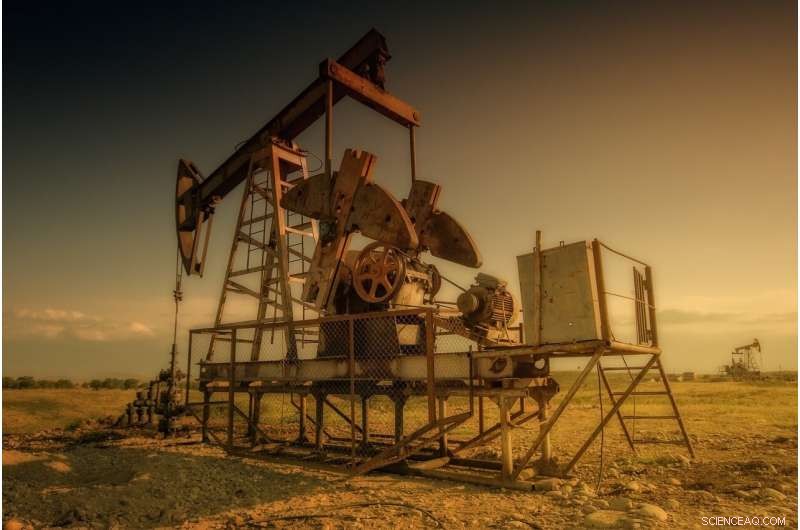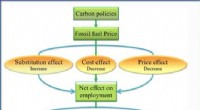
Wetenschap
De giftige erfenis van oude oliebronnen:het miljardenprobleem in Californië

Krediet:CC0 Publiek Domein
In een groot deel van Californië, fossiele brandstofbedrijven laten duizenden olie- en gasbronnen niet aangesloten en inactief, die mogelijk de gezondheid van mensen die in de buurt wonen in gevaar brengen en belastingbetalers een miljardenrekening overhandigen voor het opruimen van het milieu.
Van Kern County tot Los Angeles, bedrijven hebben lang niet genoeg geld opzij gezet om ervoor te zorgen dat deze boorlocaties worden opgeruimd en veilig worden gemaakt voor toekomstige generaties, volgens een maandenlange data-analyse en onderzoek door de Los Angeles Times en het Center for Public Integrity.
Van bijzonder belang zijn ongeveer 35, 000 putten inactief, met productie opgeschort, de helft van hen al meer dan een decennium. Hoewel Californië onlangs zijn regels heeft aangescherpt om ervoor te zorgen dat er meer opruimgeld beschikbaar is, die maatregelen gaan niet ver genoeg, volgens een recent staatsrapport en de Times/Public Integrity-analyse.
De olie-industrie in Californië is in verval, wat de kans vergroot dat bedrijven failliet gaan. Dat zou op zijn beurt de staat kunnen achterlaten met de kosten voor het opruimen van hun boorlocaties, die, als ze niet worden gesaneerd, de watervoorraden kunnen verontreinigen en dampen in de huizen van mensen kunnen verspreiden.
Onder federaal, staats- en lokale wetten, fossiele brandstofbedrijven zijn verplicht om fondsen te storten, obligaties genoemd, om ervoor te zorgen dat putten uiteindelijk worden afgesloten en gesaneerd. Deze braakleggingsfondsen zijn een reactie op de geschiedenis van de olie-industrie in de Verenigde Staten, waarin duizenden bedrijven failliet gingen zonder voldoende financiële reserves te hebben om de sanering te betalen.
Vertegenwoordigers van de industrie zeggen dat ze hun deel doen om de schoonmaak in Californië te betalen, maar hun obligaties zijn hopeloos ontoereikend om de verwachte kosten te dekken. Uit het Times/Public Integrity-onderzoek bleek dat obligaties die door de zeven grootste boormachines van Californië in de staat zijn geplaatst, die goed zijn voor meer dan 75% van de olie- en gasbronnen, bedragen ongeveer $ 230, gemiddeld, voor elke put die ze moeten ontmantelen. Andere obligaties die door federale en lokale regelgevers worden gehouden, verhogen die bedragen niet significant.
Daarentegen, de gemiddelde kosten per put voor het afdekken van putten en het ontmantelen van de bijbehorende oppervlakte-infrastructuur in Californië liggen tussen $ 40, 000 en $ 152, 000, afhankelijk van of een put zich in een landelijk of stedelijk gebied bevindt, volgens een studie die in januari werd vrijgegeven door de California Council on Science and Technology.
Het resultaat is een gapende kloof tussen wat de industrie heeft geleverd en wat uiteindelijk nodig zal zijn. Bedrijven hebben de staat slechts 110 miljoen dollar gegeven om de onshore olie- en gasbronnen van de staat op te ruimen. vond de gemeente. Eigenlijk, het zou ongeveer $ 6 miljard kunnen kosten voor die opruiming, volgens een Times/Public Integrity-analyse van staatsgegevens die aan de raad voor wetenschap en technologie zijn verstrekt.
Ontmanteling van offshore oliebronnen en platforms, die niet in die cijfers is opgenomen, zal enkele miljarden dollars kosten.
"Deze verplichtingen zijn verborgen in het volle zicht, " zei Clark Williams-Derry, een energiefinancieringsanalist bij het Institute for Energy Economics and Financial Analysis. "Ze zijn enorm, maar op de een of andere manier zijn ze voor ons onzichtbaar geworden."
Een belangrijke vraag is of de Californische olie-industrie - ooit een top-drie Amerikaanse producent - de middelen en de volharding heeft om toekomstige schoonmaakwerkzaamheden te betalen.
Vertegenwoordigers van de industrie beweren dat ze in de staat zullen zijn zolang Californiërs fossiele brandstoffen verbruiken. "Er worden belangrijke projecten voorgesteld, " zei Rock Zierman, chief executive van de California Independent Petroleum Assn., eraan toevoegend dat de olie-industrie van de staat ongeveer 18 ondersteunt, 000 banen.
Maar de olieproductie in Californië is met bijna 60% gedaald sinds het hoogtepunt in 1985, gedeeltelijk omdat de staatsvoorraden zware ruwe olie niet kunnen concurreren in een wereld die de voorkeur geeft aan goedkoper aardgas.
Omdat de staat minder olie wint, steeds meer putten blijven ongebruikt.
Als de output blijft dalen, meer gemeenschappen kunnen worden achtergelaten in de hachelijke situatie van Arvin, een grotendeels Latino stad van 20, 000 in Kern County, bezaaid met boorlocaties. Veel van die putten staan stil of produceren weinig.
Totdat dergelijke putten zijn verstopt, ze kunnen giftige emissies en ontvlambare gassen vrijgeven uit zowel hun behuizingen als de leidingen die erop zijn aangesloten. Elvia Garcia weet dat maar al te goed.
In 2014, vlammen schoten uit stopcontacten in het huis van Garcia. Haar zwangere dochter had last van plotselinge black-outs. Overheidsinspecteurs boorden testgaten in gazons en ontdekten dat er explosieve hoeveelheden gas lekten uit een pijp die aan het einde van het blok putten onderhoudt.
Ze gaven de bewoners een uur om te evacueren. Het duurde negen maanden voordat Garcia's familie mocht terugkeren.
"We rook sterke geuren van iets rottend, en die geur kwam uit de stopcontacten, ' zei ze in het Spaans. 'We dachten dat er iets tussen de muren was doodgegaan.'
Meer dan 350, 000 Californiërs wonen binnen 600 voet van niet-aangesloten putten, een Times/Public Integrity-analyse van gevonden volkstellingsgegevens. Dat is de afstand waarop mensen worden blootgesteld aan verslechterde luchtkwaliteit, volgens een rapport uit 2019 van het kantoor dat toezicht houdt op olie en gas in Los Angeles.
Van oliebronnen is bekend dat ze waarschijnlijk kankerverwekkende stoffen uitstoten, waaronder benzeen en formaldehyde. niet afgetopt, uit deze bronnen komt ook een krachtig broeikasgas vrij, methaan, die klimaatverandering helpt stimuleren.
Het Times/Public Integrity-onderzoek roept vragen op over de effecten van deze aanhoudende emissies als meer van de inactieve putten van de staat worden verlaten zonder genoeg geld om ze op te ruimen.
Het is al lang in de industrie gebruikelijk om putten tijdelijk stil te laten staan - voor onderhoudsdoeleinden, bijvoorbeeld, of wanneer de grondstofprijzen laag zijn. But according to data maintained by the California Geologic Energy Management Division, or CalGEM, the agency that regulates oil and gas producers, the oil industry since its peak-production days has doubled the instances in which it idles wells for at least two years at a time.
Most cases of oil and gas wells going idle in California are short-term. But once a well has been dormant for just 10 months, there's a 50-50 chance it will never produce again, a Times/Public Integrity analysis of 40 years of state data found. By the time federal regulators begin raising concern—at five years of inactivity—the chance that a well is ever active again falls to 1 in 4.
Industry critics say lax state regulations are allowing oil companies to walk away from wells and the liability they represent.
"All they want to do is rape the land and leave, " said state Sen. Hannah-Beth Jackson, a Santa Barbara Democrat deeply involved in attempts to regulate the oil and gas industry. "They are taking the resources of California, monetizing them and leaving us with the mess."
Zierman, of the California Independent Petroleum Assn., rejected such claims, arguing that the use of cleanup bonds and fees on both idling and production means companies bear their share of costs.
Such bonds act like a security deposit on an apartment, with the money returned if a company meets its cleanup obligations and kept by the state if it does not. If a company goes out of business without adequate bonds, the state is on the hook for the difference or, alternately, could leave the site contaminated.
Zierman also disputed the idea that the state's industry has no future. The problem, hij zei, is that state and local governments are blocking proposed projects. "Part of it is just a concerted effort to stop oil in California, " hij zei.
For their part, state regulators say they're operating under the assumption that California oil and gas is on the way out.
The role of CalGEM "is really to manage that decline, " said Jason Marshall, the Department of Conservation's chief deputy director and until late 2019 the acting head of its oil and gas division. "To make sure that when the last barrel of oil gets produced, that there are resources available so the well that produced it and all the other wells can be plugged."
State regulators say they have new tools in place to protect taxpayers and the environment.
In oktober, Gov. Gavin Newsom signed legislation that gave California more authority to limit the financial liability shouldered by taxpayers. It also mandated companies conduct more thorough reporting of emissions and liability. A month later, Newsom announced the state would study the possibility of a no-drilling buffer zone around communities.
Last April, CalGEM enacted regulations targeting idle wells. Those included increased fees on idle wells to create an incentive for producers to plug them. CalGEM, previously called the Division of Oil, Gas, and Geothermal Resources, collected $4.3 million in such fees in 2018.
Though state officials say these new regulations will better protect the state from liability, they still leave California exposed, deskundigen zeggen.
"The amount of the bonds currently on file is really small compared to the magnitude of the plugging obligations, " said Judson Boomhower, an environmental economist and assistant professor at UC San Diego who was the lead author of the California Council on Science and Technology report.
California's ability to handle the shrinking size of the industry could soon be tested. One of the state's largest producers, California Resources Corp., is responsible for the third-most idle wells of any company in the state and faces cleanup costs that far outstrip its total market value. CRC and its subsidiaries operate more than 17, 000 unplugged wells, either idle or active, including four artificial islands built to tap offshore reserves.
If CRC were to fold, other companies would probably buy some of those wells, but many could become the state's problem.
More than 7, 600 wells on pause
On many days, there's no horizon in western Kern County. Dust and pollution thrown up by the area's twin economic engines, fossil fuel extraction and large-scale agriculture, blend the hazy sky with land that's been sculpted into miles of straight-lined farms and oil fields hosting three-quarters of the state's oil and gas wells.
In this part of the county, only a chain-link fence and 1, 000 feet of dusty ground separate the fewer than 200 people living in the mobile homes and modest houses of Tupman from the 75-square-mile Elk Hills Field. This oil patch is so contaminated that a flock of sheep, 500 animals by one count, died here in 1960 when they drank from a pool of water tainted with arsenic, historically used to prevent corrosion in wells.
"Here's a nice place to come out and eat your lunch, " Rosanna Esparza, a gerontologist and Bakersfield-based community activist, said sarcastically during a September visit to the eerily quiet Tupman. She gestured toward two gray picnic tables outside Elk Hills Elementary School, which sits on the oil field's border.
Elk Hills is the largest gas-producing field in the state and the prize of California Resources Corp.'s portfolio. But this 109-year-old field is home to nearly 1, 400 of the more than 7, 600 CRC wells that were sitting idle statewide as of mid-January, according to CalGEM data examined by The Times and Public Integrity. The analysis of the most recent idle well inventory, published in September, found that CRC's idle wells haven't produced oil or gas, on average, for nearly 14 years.
This field is riddled with contaminants left behind by fossil fuel extraction. The U.S. Navy previously managed Elk Hills, and the federal government is paying the state to remediate 131 areas of concern here that contain arsenic, metals such as chromium and lead, and carcinogenic chemicals called polycyclic aromatic hydrocarbons.
"This is an example of what's going to happen in the foreseeable future when other huge oil fields start to lose their glitter, " Esparza said. "This is what happens when the oil industry starts to slip."
CRC was born in 2014 when Occidental Petroleum Corp. packaged its California assets and spun them off as a new company, shedding millions of dollars in environmental liability for Occidental in the process.
CRC has since faced harsh market forces. Oil production at the wells now owned by the company is down more than 70% since the 1980s. Gas is down more than 50%. CRC's shares had lost more than four-fifths of their value as of mid-January. The company's cash generated after expenses—a key financial measure known as net free cash flow—is several hundred million dollars in the red since splitting from Occidental, according to an analysis of U.S. Securities and Exchange Commission filings compiled by the energy analyst Williams-Derry, who has tracked CRC.
And CRC has nearly $5 billion worth of debt that's maturing by the end of 2022. Its credit rating is CCC+, which Standard &Poor's describes as "currently vulnerable" and just steps above default.
"The significant risk of this company is avoiding bankruptcy, " said Paul Sankey, an oil and gas analyst and managing director with financial firm Mizuho.
On top of all this, CRC will eventually need to address its environmental liabilities. The company's most recent SEC filing lists $511 million in future cleanup costs called "asset retirement obligations."
After examining the state's historical costs, The Times and Public Integrity found it could cost more than $1 billion to plug all the wells CRC operates.
In emailed responses, CRC spokeswoman Margita Thompson said the company delivered strong third-quarter 2019 results, with record free cash flow, some debt repayment and stable production. She also said the $1-billion figure is misleading because the state would shoulder the responsibility only if CRC were unable to pay, which she indicated would not be necessary because the company expects to make far more money off its reserves than it needs to address those liabilities. And she contended that the company can plug its own wells at a lower cost than if the state were to take over.
CRC across all its subsidiaries has more than $80 million in cleanup bonds outstanding with various agencies, satisfying its obligations, Thompson said.
She said the company takes its oil well "plugging and abandonment duties seriously, " adding that idle wells are an important part of the company's inventory because they can eventually be used again to access oil and gas formations.
"Prematurely closing wells would worsen Californians' dependence on imports from places like Saudi Arabia, " said Thompson, who earlier served as press secretary for Gov. Arnold Schwarzenegger.
Critics say CRC's approach to its aging wells raises questions about its long-term commitment to remediation.
Under California law, operators can either pay fees or agree to plug long-idled wells. Of the 10 operators with the most long-idled wells in the state, the only ones that opted for fees instead of cleanup were two CRC subsidiaries, according to data obtained via public records requests.
Holding off on decommissioning minimizes short-term costs, but it comes with uncertain consequences for California if CRC gets into deeper financial difficulties.
"A single bankruptcy among one of these large companies could potentially create a large number of orphan wells, " the recent California Council on Science and Technology report said, specifically mentioning CRC.
Williams-Derry compared CRC's situation to short-lived coal companies that took on high levels of liability in recent years as they spun off from major producers that were financially hurting. "Those were companies that to all appearances were designed to fail, " hij zei.
Industry lobbies to limit cleanup obligations
People living near unplugged oil and gas wells face exposure to cancer-causing chemicals, and toxic residue brought up by drilling below Earth's surface can contaminate aquifers that could become future drinking water supplies.
Dit jaar, California lawmakers are considering a bill that would create a 2, 500-foot buffer separating wells from homes, schools, hospitals and other public buildings.
According to a Times/Public Integrity analysis, more than 2 million Californians live within that distance of an unplugged oil or gas well, with Latino, black and low-income people living nearby at a slightly higher rate than the California population as a whole. Half of those 2 million people reside in Los Angeles.
A strict buffer requirement faces long odds in the Legislature. It's opposed by labor and oil industry groups, two of Sacramento's most well-funded lobbying forces.
in 2016, when lawmakers were considering legislation that ultimately overhauled the management of idle wells, the Western States Petroleum Assn., a trade group representing oil and gas interests, reported spending $7 million to lobby on it and other bills. Over the last five years, the trade group pumped more than $41 million into lobbying in California, by far the most of any organization in the state.
Das Williams, now a Santa Barbara County supervisor and formerly a Democratic member of the Legislature, sponsored the 2016 legislation after it became clear that decommissioning offshore oil infrastructure would be costly for the state. That law also increased state bonding, although not to the level its authors had hoped. Williams said that industry groups occupied an opposing seat at the bargaining table and that the bill's language was "a product of haggling."
The resulting changes to how the state manages idle wells have produced some progress on cleanup, according to a study CalGEM released in November. Companies plugged 988 long-term idle wells in 2018, and nine operators decommissioned more wells than the statute required.
"It's doing what we wanted it to do, " said Marshall, with the Department of Conservation.
But companies continue to put off more expensive cleanup jobs in urban areas such as Los Angeles, instead focusing on rural wells that are easier to decommission, mainly in Kern County. That finding is based on data The Times and Public Integrity obtained for every well-plugging plan that operators submitted and CalGEM approved in 2019.
If these wells are left open, the state will need to step in.
Because the money that defunct companies had set aside for cleanup usually falls short, the state relies on fees on idle wells and production. By law, CalGEM isn't allowed to spend more than $3 million a year to plug orphan wells, a temporary increase that will drop back to $1 million after 2021. The agency has plugged more than 1, 350 such wells since 1977.
From Appalachia to the Mountain West, many other states are in a similar predicament, struggling to address cleanup of old oil wells. Utah acknowledged a funding shortfall in November, bijvoorbeeld, and Colorado announced its cleanup would cost 14 times more than what companies set aside.
Boomhower, the California Council on Science and Technology bonding report's lead author, said oil companies often find it cheaper to forfeit an insufficient bond than to pay for cleanup and capping. "You do have to worry that some of these small and mid-sized operators don't have incentive to clean up, " hij zei.
In Arvin, fumes remain near homes and schools
Five years ago, Elvia Garcia returned to her home in Arvin, which she said had been looted while she was gone. Vanaf dat moment, her family has continued to suffer from lingering headaches brought on by occasional odors. State regulators fined the company responsible for the leak, Petro Capital Resources LLC. The company installed machines on homes in the neighborhood, including Garcia's, to remove gas—and vent it into backyards.
During a September visit to Arvin, various wells near Garcia's neighborhood hummed as they pulled up a trickle of hydrocarbons. The odor of mercaptan, the compound added to natural gas to give it its distinctive smell, hung in the air. At one site, oil stained a patch of dirt, the leak appearing to originate from another company's storage tank.
The largely disused wells here are part of a trend. At the industry's peak, about 2.5 times as many wells produced as sat idle statewide. That ratio has fallen to about 1.5 times as many active as idle wells, the Times/Public Integrity analysis found.
Francisco Gonzalez, who lives down the street from Garcia, moved to Arvin to enjoy a quiet retirement outside Los Angeles. He said his family still smells nauseating levels of gas at certain times, and he worries about the health of children attending the schools across the street from wells.
"What is the company going to do?" he asked in Spanish. "They are not going to do anything."
Jeff Williams, Petro Capital Resources' production manager, said there can't be leaks in homes, because the pipeline hasn't been used since 2014 and wells are pulling up only enough gas to relieve pressure buildup. He said the company has no near-term plans to plug and abandon the wells because it hopes to one day restart production there.
Two blocks away, next to Arvin High School, 25 unplugged wells owned by a company called Sunray Petroleum Inc. sit deserted, 40 years after some of them last operated. Pump jacks rise above fields of almond saplings like rusting scarecrows.
Sunray, which filed for bankruptcy in 2011 and has racked up numerous violations for unpaid fees and inadequate pollution monitoring, saw its production fall off a cliff in the late 1980s. The last of its wells went quiet in 2015.
A phone number listed for the company has been disconnected, and other attempts to reach Sunray proved futile. The company has posted a cleanup bond for its wells, but it is far less than what the law requires and what will ultimately be needed for cleanup.
In March 2017, CalGEM mailed a notice of violation to the Las Vegas-based company. In a certified letter, the division wrote that Sunray ignored requirements to test its long-idled wells, including those near Arvin High School, for indications of groundwater contamination. The agency said that failure to submit those tests could constitute a crime.
The post office sent the letter back to CalGEM with this stamp:"RETURN TO SENDER. UNCLAIMED. UNABLE TO FORWARD."
©2020 Los Angeles Times
Gedistribueerd door Tribune Content Agency, LLC.
 Houtfilter verwijdert giftige kleurstof uit water
Houtfilter verwijdert giftige kleurstof uit water Koolhydraten vastleggen
Koolhydraten vastleggen Bio-ingenieurs onthullen verrassende zintuiglijke en zelfgenezende vermogens van zeedieren
Bio-ingenieurs onthullen verrassende zintuiglijke en zelfgenezende vermogens van zeedieren Onderzoekers ontwikkelen een modulair metaal-organisch raamwerk met de hoogste elektronladingsmobiliteit ooit waargenomen
Onderzoekers ontwikkelen een modulair metaal-organisch raamwerk met de hoogste elektronladingsmobiliteit ooit waargenomen Hoe een Galilean-thermometer te maken
Hoe een Galilean-thermometer te maken
 Cedar Tree Identification
Cedar Tree Identification Zeldzame gasvondst lost puzzel op van stijgend landschap in zuidelijk Afrika
Zeldzame gasvondst lost puzzel op van stijgend landschap in zuidelijk Afrika Studie voorspelt meer zeespiegelstijging op lange termijn door Groenlands ijs
Studie voorspelt meer zeespiegelstijging op lange termijn door Groenlands ijs Kleine fossielen met grote toepassingen—De tijdschaal van de BP Golf van Mexico—Een stapsgewijze verandering in tijdsresolutie
Kleine fossielen met grote toepassingen—De tijdschaal van de BP Golf van Mexico—Een stapsgewijze verandering in tijdsresolutie aardbeving met een kracht van 5,8 op de schaal van Richter schudt Istanbul door elkaar 8 lichtgewond
aardbeving met een kracht van 5,8 op de schaal van Richter schudt Istanbul door elkaar 8 lichtgewond
Hoofdlijnen
- Californische vogels nestelen een week eerder dan een eeuw geleden
- Wat zijn de subeenheden van DNA?
- Wetenschappers afluisteren onbekende spitssnuitdolfijnen af om te zien hoe diep ze duiken
- Wetenschappers bundelen hun krachten om Puerto Ricos Monkey Island te redden
- Een driedimensionaal DNA-model maken voor de biologie van de middelbare school
Door een model van een DNA-helix in de klas te bouwen, kunnen studenten de constructie van DNA beter visualiseren en meer te weten komen over de levengevende genetische
- Freud en Oedipus:doet een van beide er nog toe?
- Wat is de sequentie van basen op de complementaire DNA-streng?
- Mannetjes passen de snelheid van het sperma snel aan om rivalen te verslaan, studie vondsten
- Wat is landbouwbiotechnologie?
- We kunnen het milieu duurzaam beheren, maar we moeten eraan werken

- Nieuwe studiemodellen impact stijgende fossiele brandstofprijzen op werkgelegenheid

- Gevolgen voor het milieu van triplex

- Onderzoekers ontdekken ontbrekend stukje Hawaï-formatie

- Gezondheidseffecten van rook nemen toe bij hevigere bosbranden

 Stroomsnelheden berekenen
Stroomsnelheden berekenen  Vroege jagers op groot wild in Amerika waren vrouwelijk, onderzoekers suggereren:
Vroege jagers op groot wild in Amerika waren vrouwelijk, onderzoekers suggereren: Belang van verwering
Belang van verwering  Hoe Conductivity
Hoe Conductivity Kans dat asteroïde Bennu de aarde raakt in perspectief gezet
Kans dat asteroïde Bennu de aarde raakt in perspectief gezet Ultra-duse melkweg VCC 1287 in detail onderzocht
Ultra-duse melkweg VCC 1287 in detail onderzocht De verschillen tussen 1D-, 2D- en 3D-afbeeldingen
De verschillen tussen 1D-, 2D- en 3D-afbeeldingen  Wat zijn de soorten rotsen in de Appalachen?
Wat zijn de soorten rotsen in de Appalachen?
- Elektronica
- Biologie
- Zonsverduistering
- Wiskunde
- French | Italian | Portuguese | Swedish | German | Dutch | Danish | Norway | Spanish |

-
Wetenschap © https://nl.scienceaq.com

